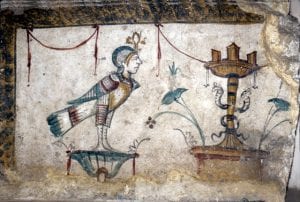Envision the Afterlife Through the Past
 The Central Florida Society of the Archaeological Institute of America introduces their 2013-2014 lecture series with Dr. Marjorie Venit presenting her talk entitled “Imaging the Afterlife: Cultural Exchange in Monumental Tombs of Graeco-Roman Egypt.” The lecture will be held on October 4, 2013 at 7:00pm in the Psychology Building room 108.
The Central Florida Society of the Archaeological Institute of America introduces their 2013-2014 lecture series with Dr. Marjorie Venit presenting her talk entitled “Imaging the Afterlife: Cultural Exchange in Monumental Tombs of Graeco-Roman Egypt.” The lecture will be held on October 4, 2013 at 7:00pm in the Psychology Building room 108.
Dr. Venit is a Professor of Ancient Mediterranean Art and Architecture with the University of Maryland. She earned an M.A. from the San Francisco Art Institute, Hunter College-CUNY and an M.A. and Ph.D. from the Institute of Fine Arts, New York University. Her research focuses on tombs and their decoration in Ptolemaic and Roman-period Egypt, and Greek vase painting. Dr. Venit has received numerous awards and grants, and her main publications include “Monumental Tombs of Ancient Alexandria: The Theater of the Dead” (Cambridge University Press, 2002).
Abstract: “Imaging the Afterlife: Cultural Exchange in Monumental Tombs of Graeco-Roman Egypt.”
The period from the third-century bce through the mid-third century ce marks a dramatic change in Egypt. Alexander the Great’s conquest in 331 bce, and Egypt’s subsequent rule by Greeks (and then Romans) and the immigration into Egypt that resulted, generated intellectual interaction far beyond that permitted by former political alliances and economic relationships. Immigrating Greeks carried with them their own conception of death and afterlife, and these ideologies persisted in Egypt well after the polity’s Roman conquest. Yet despite the elite status their role as conquerors conferred, Greeks still recognized that Egypt had dominion over death. Concurrently, Egyptians having suffered centuries of foreign rule had lost some of their earlier eschatological self-confidence. Each group stood psychologically ready to cast a wider net to ensure a blessed afterlife, and the contiguity of cultures profited each.
This paper addresses the cross-cultural reciprocity observed in selected tombs in Alexandria and the Egyptian chora, arguing a rhetorical intentionality animating the interchange of image and its execution. It maintains that by enriching the visual vocabulary and representational range of each of the two major constituencies in Graeco-Roman Egypt, this exchange of form and content permitted a rhetorical depth far greater than either could have alone achieved, allowing each a more expansive negotiation of “the radical alterity of death.”
The lecture is free and open to the public. Parking will be $1 at the door. A reception will be held in the lobby immediately following the lecture.
